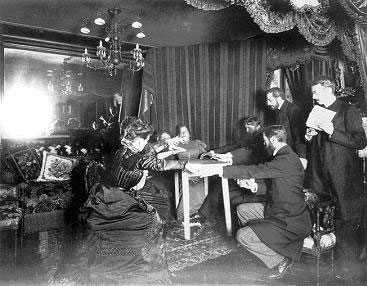
Eusapia Palladino during a seance
Throughout her childhood, which seems otherwise to have been uneventful, she was subject to a variety of visual and auditory hallucinations, evidently more psychological than psychic. Nonetheless, automatism is recorded as having begun quite early in her life, although they were singularly self-contained, that is sensory or mental, their being made conscious to other persons only by her revelations of them. Mlle. Smith’s initial contact with spiritism occurred in the winter of 1891-1892 when she was given a book titled Après la Mort, [20] and on February 20, as a complete novice, she participated in her first séance wherein the attempt was for automatic writing. In notes of six days later the medium (kept anonymous by Flournoy) wrote: “. . . progress; the table moves itself considerably, salutes one by one all the members of the group, and gives certain names, of which only one is recognized . . .” Not quite three weeks later the sensitive entered in her diary: “Progress; clear communication by the table. Attempt to experiment in the darkness (which was not absolute… we could distinguish each other with difficulty). Mlle. Smith sees a balloon, now luminous, now becoming dark; she has seen nothing up to this time. Writing: Mlle. Smith writes mechanically a quite long communication from the father of M. K. [a Bulgarian student present at the séance]; advice to him.” [21]
The assembly had by now become numerically unwieldy and it was divided into two separate sittings. Mlle. Smith became the secretary and transcriber of one of them, writing of herself in the third person in her notes. On March 25, she recorded: “Eleven persons around a large and heavy dining-table of oak with two leaves. The table is set in motion, and several spirits come and give their names (by raps), and testify… Mlle. Smith begins to distinguish vague gleams with long white streamers moving from the floor to the ceiling, and then a Magnificent star, which appears to her alone [22] the whole of the séance.” [23]
A week later in the results of another session is remarked:
Violent movements of the table, due to a spirit who calls himself David and announces himself as the spiritual guide of the group. Then he gives way to another spirit who says he is Victor Hugo, and the guide and protector of Mlle. Smith . . .he soon disappears (as these were notectoplasmic manifestations one assumes she means “went away”) … (Smith) sees suddenly, balancing itself above the table, a grinning, very ill-favored face, with long red hair… The figure (sic) disappears. (Then) she sees a magnificent bouquet of roses of different hues being placed on the table… (with) a small snake coming out from (it).
Abruptly everything is gone, and three raps conclude the ceremony. Such was the beginning of Hélène Smith in the world of spiritualism. In her subsequent formative years she passed through three major phases in her somnambulistic trances. There was a period, previously noted, when Victor Hugo reigned alone as her spiritual mentor; this persisted for about five months. Then, for about twelve months he seems to have little control against the invasive tactic of one Leopold who asserted increasing authority as the preeminent guide. Finally, during a high point in her career, there was a six-year phase when the intruder (August 26, 1892), who identified himself as the great mystic Joseph (né Giuseppe) Balsamo [24] dominated the scene on the other side. Despite the efforts of the sitters to dispel his presence and reinforce the strength of Victor Hugo, the mountebank implements his desires and becomes the major control of Mlle. Smith, much of which is hostile and full of animus.
Extremely rare are two further orders of quasi-medium who also function graphically. First there are those mediums who draw images of deceased persons whom they have never seen, or, for that matter, heard of before the session. The only one of these the author has ever known personally was Grace Rosher, a distinguished member of the Spiritualist Association of Great Britain located in London. The second type, again unique to this writer, was Rosemary Brown, who transcribed original music from the spirits of Chopin, Mozart, and other equally famous composers. The music medium revealed that her mother, half-Scottish, had second sight and was a clairvoyant, and that her father, who had converted from atheism because of spirit messages she had conveyed to him, had the gift of mind-reading.
During the interview, it was established that Miss Brown had, curiously, at the age of seven, taken a year’s worth of lessons from a jazz pianist and had studied for two years with a qualified teacher during her adolescence. Nonetheless, Rosemary Brown’s music teacher, Mary Firth, was of the opinion that the medium [25] had no intrinsic musical ability. Still, she had recorded a great many works from a variety of composers in numerous styles, frequently from Chopin, Brahams, and Liszt. Most often she was in touch with the less well-known Sir Donald Francis Tovey, English composer and musicologist, Professor of Music at Edinburgh University, best know for his symphony, a concerto for violincello and orchestra, and the opera The Bride of Dionysus. [26]
20 “After Death.” Back to text
21 From India to the Planet Mars. p. 37 Back to text
22 Emphasis added. Back to text
23 From India to the Planet Mars. p. 38 Back to text
24 Commonly known as the Count Alessandro di Cagliostro. (1743-1795) Back to text
25 She was also known to have forecast violent earthquakes in the Middle East. Back to text
26 (1875-1940). Also the author of the five-volume work: Essays in Musical Analysis. Back to text

